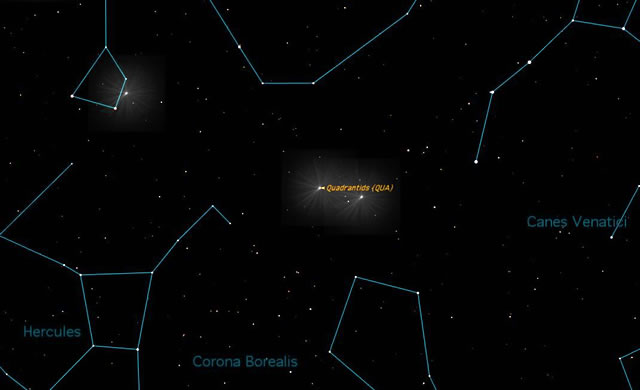
La prima pioggia di meteore, comunemente chiamate “stelle cadenti”, avrà luogo questo primo fine settimana del 2013 e darà la possibilità agli appassionati di iniziare l’anno nuovo con un celestiale spettacolo astronomico. Le Quadrantidi sono un evento annuale, e si verifica ogni Gennaio. Anche quest’anno queste stelle cadenti non mancheranno di mettere in ombra alcuni degli sciami meteorici più spettacolari del 2012, e possono senz’altro essere, in presenza di notti limpide e libere da nubi, un ottimo e stupendo inizio per il nuovo anno, non solo per gli astrofili.
La Terra è in procinto di passare attraverso un flusso di detriti di 2003 EH1, un frammento di cometa che produce la famosa pioggia annuale di meteore. Il momento di massima visibilità dovrebbe verificarsi la mattina di giovedi 3 Gennaio, probabilmente durante alcune ore intorno alle 5 PST (1300 UT). Previste al massimo fino a 100 meteore all’ora, potrebbero emergere dalla zona intorno a Polaris, la stella del nord. Purtroppo, il riflesso dovuto alla Luna calante limiterà di molto il numero di meteore visibili.
The first meteor shower of 2013 will kick off the year’s night sky events this week, giving stargazers a chance to ring in the New Year with a celestial fireworks display. The Quadrantid meteor shower is an annual meteor shower every January. While this year’s “shooting star” show is not expected to outshine some of the more spectacular meteor showers of 2012, it may give stargazers with clear, dark skies a great start to the New Year.
Source/Continue reading → SPACE.com
Earth is about to pass through a stream of debris from 2003 EH1, a comet fragment that produces the annual Quadrantid meteor shower. The shower peaks on Thursday morning, January 3rd, probably during a few-hour period around 5 am PST (1300 UT). At maximum, as many as 100 meteors/hour could emerge from a radiant near Polaris, the north star. Unfortunately, glare from a waning gibbous moon will wash out many Quadrantids, reducing the visibility of the display.
Source/Continue reading → SpaceWeather.com

















